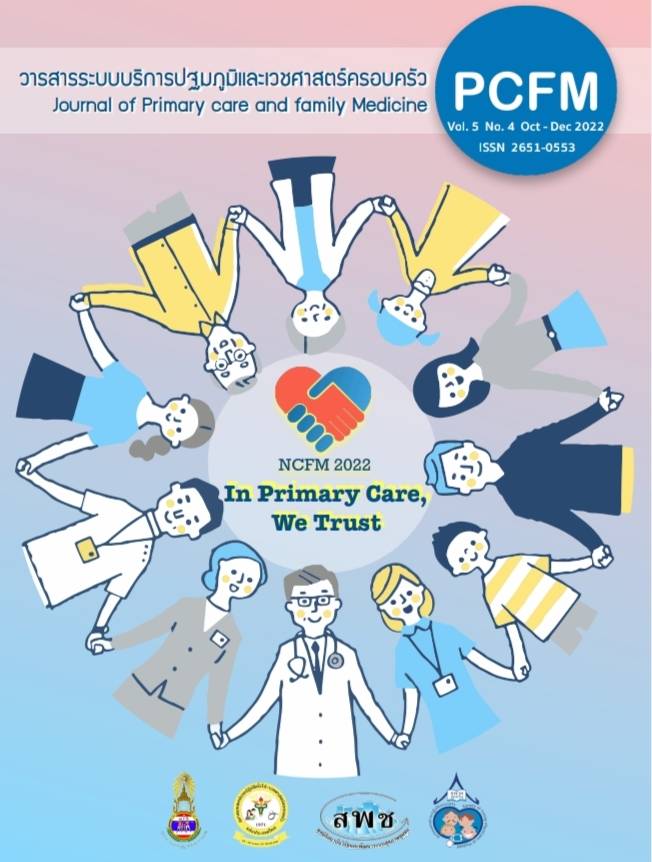คุณภาพชีวิต และภาวะซึมเศร้าในผู้ป่วยโรคไตเรื้อรังระยะสุดท้าย ที่ได้รับการล้างไตทางช่องท้องอย่างต่อเนื่อง
Main Article Content
บทคัดย่อ
ที่มา: การล้างไตทางช่องท้องอย่างต่อเนื่องเป็นวิธีการบำบัดทดแทนไตที่เป็นทางเลือกหลักในผู้ป่วย่ โรคไตเรื้อรังระยะสุุดท้ายของประเทศไทย การศึกษาคุณภาพชีวิตและภาวะซึมเศร้าในผู้ป่วยที่ได้รับการล้างไตทางช่องท้องอย่างต่อเนื่องในประเทศไทยยังมีจำกัด
วัตถุประสงค์: เพื่อศึกษาคุณภาพชีวิต และความชุกของภาวะซึมเศร้า รวมถึงปัจจัยที่มีผลต่อคุุณภาพชีวิต และภาวะซึมเศร้าในผู้ป่วยโรคไตเรื้อรังระยะสุดท้ายที่ได้รับการล้างไตทางช่องท้องอย่างต่อเนื่อง
วัสดุและวิธีการ: การศึกษาเชิงวิเคราะห์ภาคตัดขวางในผู้ป่วยโรคไตเรื้อรังระยะสุดท้ายที่ได้รับการล้างไตทางช่องท้องอย่างต่อเนื่อง 110 ราย ณ โรงพยาบาลชลบุรี เก็บข้อมูลด้วยแบบสอบถามข้อมูลทั่วไป แบบสอบถามคุณภาพชีวิต และแบบคัดกรองภาวะซึมเศร้า ใช้สถิติเชิง
พรรณนา สมการถดถอยโลจิสติกแบบพหุและสมการถดถอยโลจิสติกแบบไบนารี
ผลการศึกษา: กลุ่มตัวอย่างร้อยละ 91.8 มีคุณภาพชีวิตในระดับดีถึงดีมาก ความชุกของภาวะซึมเศร้าเป็นร้อยละ 20.91 ความเพียงพอของรายได้มีผลต่อคุณภาพชีวิตด้านความผาสุกทางจิตใจ (OR = 10.088, 95% CI = 1.187-85.715, P = 0.034) การมีภาวะแทรกซ้อนขณะล้้งไตมีผลต่อคุณภาพชีวิตด้านการดำรงชีวิตอยู่กับการฟอกไต (OR = 0.233, 95%CI = 0.060-0.905, p = 0.035) และภาวะซึมเศร้ามีผลต่อคุณภาพชีวิตด้านการดำรงชีวิตอยู่กับอาการแสดง (OR = 0.071, 95% CI = 0.012-0.424, p = 0.004) ส่วนปัจจัยที่มีผลต่อภาวะซึมเศร้า คือ ความไม่เพียงพอของรายได้ (OR = 8.562, 95% CI = 1.935-37.892,
p = 0.005) และการมีโรคเบาหวานร่วม (OR = 6.131, 95% CI = 1.622-23.182, p = 0.008)
สรุุป: ผู้ป่วยไตเรื้อรังระยะสุดท้ายที่ได้รับการล้างไตทางช่องท้องอย่างต่อเนื่องส่วนใหญ่มีคุณภาพชีวิตอยู่ในระดับดีถึงดีมาก อย่างไรก็ตามภาวะซึมเศร้าพบได้ในผู้ป่วยเหล่านี้ถึึง 1 ใน 5 ผู้ป่วยที่มีปัญหาความเพียงพอของรายได้และการมีโรคเบาหวานเป็นกลุ่มเสี่ยงของภาวะ
ซึมเศร้า
Article Details

อนุญาตภายใต้เงื่อนไข Creative Commons Attribution-NonCommercial-NoDerivatives 4.0 International License.
เนื้อหาและข้อมูลในบทความที่ลงตีพิมพ์ในวารสาร PCFM ถือเป็นข้อคิดเห็นและความรับผิดชอบของผู้เขียนบทความโดยตรง ซึ่งกองบรรณาธิการวารสารไม่จำเป็นต้องเห็นด้วยหรือร่วมรับผิดชอบใด ๆ
บทความ ข้อมูล เนื้อหา รูปภาพ ฯลฯ ที่ได้รับการตีพิมพ์ลงในวารสาร PCFM ถือเป็นลิขสิทธิ์ของวารสาร PCFM หากบุคคลหรือหน่วยงานใดต้องการนำทั้งหมดหรือส่วนหนึ่งส่วนใดไปเผยแพร่ต่อหรือเพื่อกระทำการใด ๆ จะต้องได้รับอนุญาตเป็นลายลักษณ์อักษรจากวารสาร PCFM ก่อนเท่านั้น
เอกสารอ้างอิง
Chittinandana A, Chailimpamontree W, Chaloe- iphap P. Prevalence of chronic kidney disease in Thai adult population. J Med Assoc Thai. 2006;89 [2 Suppl]:112-20.
Praditpornsilpa K. Thailand renal replacement therapy year 2007 [Internet]. 2009. [cited 24 Mar 2022]. Available from: https://www.nephrothai.org/wp-content/uploads/2020/08/Thailand_Renal__Replacement_Therapy_2007_25-Nov_2009_com- plete_New.pdf.
Chuasuwan A, Lumpaopong A. Thailand renal re- placement therapy year 2020 [Internet]. 2021 [cited 24 Mar 2022]. Available from: https://www.nephrothai.org/wp-content/uploads/2021/10/Fi- nal-TRT-report-2020.pdf.
พงศธร คชเสนี. การบำ บัดทดแทนไตในปัจจุบัน [อินเตอร์เนต]. 2020. [เข้าถึงเมื่อ 2565 ก.พ. 22]. เข้าถึงได้จาก: https://www.nephrothai.org/wp-content/up- loads/2020/08/การบำ บัดทดแทนไตในปัจจุบัน.pdf.
สำนักงานหลักประกันสุขภาพแห่งชาติ. สปสช.แจงเกณฑ์ เบิกจ่ายรองรับนโยบายใหม่ ผู้ป่วยไตวายสิทธิบัตรทอง ‘เลือดฟอกไตแบบที่ใช่ได้ทุกคน’ [อินเตอร์เนต]. 2022 [เข้าถึงเมื่อ 2565 ก.พ. 22]. เข้าถึงได้จาก: https://www.nhso.go.th/news/3477.
Affinito J, Louie K. Positive coping and self- assessed levels of health and burden in un- paid caregivers of patients with end stage renal disease receiving hemodialysis therapy. Nephrol Nurs J. 2018;45:373-9.
Chen JY, Wan EYF, Choi EPH, Chan AKC, Chan KHY, Tsang JPY, Lam CLK. The health-related quality of life of chinese patients on hemodialysis and perito- neal dialysis. Patient. 2017;10:799-808.
พนิดา เทียมจรรยา, ชมนาด วรรณพรศิริ, ดวงพร หุ่นตระกูล. การดูแลตนเองของผู้ป่วยที่มีการติดเชื้อของเยื่อบุช่องท้องจากการรักษาด้วยการล้างไตทางช่องท้องอย่างต่อเนื่อง. วารสารการพยาบาลและสุขภาพ. 2554;5:92-103.
Abdel-Kader K, Unruh M, Weisbord S. Symptom Burden, Depression, and Quality of Life in Chronic and End-Stage Kidney Disease. Clin J Am Soc Neph- rol. 2009;4:1057-64.
สมจิตร สกุลคู, วันเพ็ญ วิศิษฏ์ชัยนนท์, วราทิพย์ แก่นการ. ปัจจัยที่มีอิทธิพลต่อคุณภาพชีวิตในผู้ป่วยโรคไตเรื้อรังระยะสุดท้ายที่ได้รับการล้างไตทางช่องท้องอย่างต่อเนื่อง. วารสารการพยาบาลและการดแูลสุขภาพ. 2563;38:117-26.
Cohen SD, Norris L, Acquaviva K, Peterson RA, Kim- mel PL. Screening, diagnosis, and treatment of de- pression in patients with end-stage renal disease. Clin J Am Soc Nephrol. 2007;2:1332.
อุทุมพร ขำคม, นันทิยา วัฒายุ, ดวงใจ รัตนธัญญา. ปัจจัยทำนายคุณภาพชีวิตของผู้ป่วยไตวายเรื้อรังที่ได้รับการล้างไตทางช่องท้องด้วยตนเองแบบต่อเนื่อง. วารสารพยาบาลศาสตร์จุฬาลงกรณ์มหาวิทยาลัย. 2558;27:60-71.
ประพัฒน์สินี ประไพวงษ์, อรวมน ศรียุกตศุทธ, กุสุมา ณ อยุธยา, นพพร ว่องสิริมาศ. ปัจจัยที่มีอิทธิพลต่อคุณภาพชีวิตในผู้หญิงท่ีได้รับการล้างไตทางช่องท้องแบบต่อเนื่อง. วารสารมหาวิทยาลยนั ราธวิาสราชนครินทร์. 2558;7:37-48.
ศิริอร สินธุ, รสสุคนธ์ วาริทสกุล, อรวมน ศรียุกตศุทธ. ปัจจัยที่สัมพันธ์กับภาวะซึมเศร้าในผู้สูงอายุที่รับการรักษาด้วย การล้างไตทางช่องท้อง. วารสารพยาบาลศาสตร์. 2554;29:84-92.
Lin YH, Yang Y, Chen SY, Chang CC, Chiu PF, Huang CY. The depression status of patients with endstage renal disease in different renal replacement therapies. Int J Urol Nurs. 2011;5:14-20.
Feroze U, Martin D, Reina-Patton A, Kalantar-Zadeh K, Kopple JD. Mental health, depression, and anxiety in patients on maintenance dialysis. Iran J Kidney Dis. 2010;4:173-80.
Chan LK, Yu EC, Li SY. Depression in patients receiv- ing peritoneal dialysis. East Asian Arch Psychiatry. 2011;21:99-107.
Lin J, Guo Q, Ye X, Li J, Yi C, Zhang X, et al. The ef- fect of social support and coping style on depres- sion in patients with continuous ambulatory peri- toneal dialysis in southern China. Int Urol Nephrol. 2013;45:527-35.
Pukpobsuk N, Panpakdee O, Maneesriwongul W, Viwatwongkasem C, Ingsathit A. Development and psychometric properties of the Thai Health-Related Quality of life instrument for dialysis patients. Pac Rim Int J Nurs Res. 2012;16:154-68.
Lew QLJ, Allen JC, Nguyen F, Tan NC, Jafar TH. Fac- tors Associated with Chronic Kidney Disease and Their Clinical Utility in Primary Care Clinics in a Multi-Ethnic Southeast Asian Population. Nephron. 2018;138:202-13.
สำนักงานสถิติแห่งชาติ. สถิติรายได้และรายจ่ายของครัวเรือน [อินเทอร์เนต]. 2563. [เข้าถึงเมื่อ 2565 ธ.ค. 1]. เข้าถึงได้จาก: http://statbbi.nso.go.th/staticreport/page/sector/th/08.aspx.
อังคนา จงเจริญ, วัชรี รัตนวงศ์. ประสิทธิผลของศูนย์เรียนรู้นวัตกรรมทางการพยาบาลเพื่อการสร้างเสริมสุขภาพ;ระบบการดูแลผู้ป่วยที่ได้รับการรักษาด้วยการล้างไตทางหน้าท้อง (CAPD) ในโรงพยาบาลชลบุรี. วารสารพยาบาลสภากาชาดไทย. 2561;11:97-109.
วนิดา วิชัยศักดิ์, พีรพนธ์ ลือบุญธวัชชัย, ยิ่งยศ อวิหิงสานนท์. การศึกษาเปรียบเทียบคุณภาพชวีิตระหว่างกลุ่มผูป้วย่ โรคไตวายระยะสุดท้ายที่รักษาด้วยการฟอกเลือด หรือการล้างไตทางช่องท้อง และกลุ่มผู้ป่วยที่ได้รับการผ่าตัดเปลี่ยนไตในโรงพยาบาลจุฬาลงกรณ์. Chulalongkorn Medical Journal. 2561;62:91-105.
อรวมน ศรียุกตศุทธ, นพพร ว่องสิริมาศ, ณัฏยา ประหา, ประพัฒน์สินี ประไพวงษ์. คุณภาพชีวิตและปัจจัยที่เกี่ยวข้องในผู้หญิงที่ได้รับการฟอกเลือดด้วยเครื่องไตเทียม และล้างไตทางช่องท้องแบบต่อเนื่อง. วารสารพยาบาลศาสตร์. 2560; 35:72-84.
ศิริรักษ์ อยันต์ณัฐศิริ. การติดเชื้อในผู้ป่วยที่ได้รับการล้างไตทางช่องท้องชนิดถาวร. ใน: ทวี ศิริวงศ์, บรรณาธิการ. การล้างช่องท้องอย่างถาวรสองฝั่งโขง. ขอนแก่น: มหาวิทยาลัยขอนแก่น; 2549:75-81.
คัทลียา อุคติ, ณัฐนิช จันทจิรโกวิท. ความสามารถในการดูแลตนเองและคุณภาพชีวิตของผู้ป่วยภาวะไตวายเรื้อรังระยะสุดท้ายที่รักษาด้วยวิธีการขจัดของเสียทางเยื่อบุช่องท้องต่อเนื่อง. สงขลานครินทร์เวชสาร. 2550;25:171-77.
อาทิตยา อติวิชญานนท์, สายฝน ม่วงคุ้ม, วชิราภรณ์ สุมนวงศ์. ปัจจัยทำนายภาวะซึมเศร้าในผู้ป่วยล้างไตทางช่องท้องอย่างต่อเนื่อง. วารสารคณะพยาบาลศาสตร์ มหาวิทยาลัยบูรพา. 2562;27:49-59.
King-Wing Ma T, Kam-Tao Li P. Depression in dialy- sis patients. Nephrology (Carlton). 2016;21:639-46.


